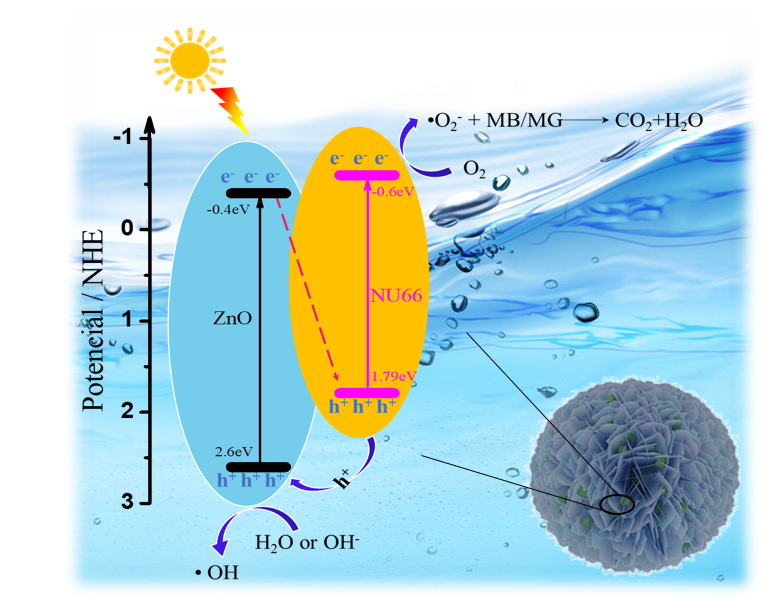 Open Access
Open Access
ARTICLE
Remarkably Enhanced Photodegradation of Organic Pollutants by NH2-UiO-66/ZnO Composite under Visible-Light Irradiation
1 National Engineering Research Center for Marine Aquaculture, Zhejiang Ocean University, Zhoushan, 316004, China
2 Marine Science and Technology College, Zhejiang Ocean University, Zhoushan, 316004, China
* Corresponding Authors: Jing Chen. Email: ; Shaohong Zang. Email:
# These authors contributed equally to this work
Journal of Renewable Materials 2022, 10(9), 2378-2391. https://doi.org/10.32604/jrm.2022.019209
Received 09 September 2021; Accepted 24 November 2021; Issue published 30 May 2022
Abstract
Semiconductor photocatalysis is a novel highly efficient and low-cost method for removing organic pollutants from wastewater. However, the photoreduction performance of semiconductors on organic pollutants is limited due to the weak absorption of visible light caused by its wide band gap and low carrier utilization rate resulting from severe electron-holes recombination. In the present study, flower-like NH2-UiO-66 (NU66)/ZnO nanocomposites were prepared using a facile method and exhibited high efficiency under visible light driven photocatalysts. The X-ray diffractometer (XRD), scanning electron microscope (SEM), transmitor electron microscope (TEM), and X-ray photoelectron spectroscopy (XPS) were used to characterize the prepared samples, indicating that NU66/ZnO was successfully synthesized. The photocatalytic activity of the prepared NU66/ZnO nanocomposites was determined by measuring the photodegradation of methylene blue (MB) and malachite green (MG) under visible-light irradiation. The optimal nanocomposite loading of 5% wt NU66 to NU66/ZnO demonstrated the highest photocatalytic activity for the degradation of MB. The photocatalytic activity of a 5% NU66/ZnO composite was approximately 95-fold and 19-fold higher than that of NU66 and ZnO samples, respectively. The enhanced activity of the 5% wt NU66/ZnO nanocomposite was further confirmed through photoelectrochemical analysis. The formation of type II heterojunctions between the counterparts significantly suppressed recombination of the photogenerated charge carriers. Photocatalytic degradation experiments with different quenchers indicated that the effect of superoxide anion radicals (•O2− ) had a greater effect than the other scavengers. Additionally, the improved photocatalytic mechanism underlying the activity of NU66/ZnO nanocomposites was also explored. These findings establish a basis for development of MOF based heterojunction for photocatalytic organic pollution remediation.Graphic Abstract

Keywords
Cite This Article
 Copyright © 2022 The Author(s). Published by Tech Science Press.
Copyright © 2022 The Author(s). Published by Tech Science Press.This work is licensed under a Creative Commons Attribution 4.0 International License , which permits unrestricted use, distribution, and reproduction in any medium, provided the original work is properly cited.


 Submit a Paper
Submit a Paper Propose a Special lssue
Propose a Special lssue View Full Text
View Full Text Download PDF
Download PDF Downloads
Downloads
 Citation Tools
Citation Tools
